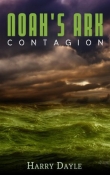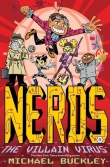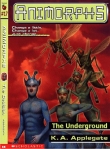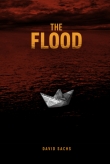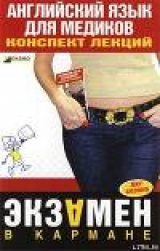
Текст книги "Английский язык для медиков: конспект лекций"
Автор книги: Елена Беликова
Жанры:
Языкознание
,сообщить о нарушении
Текущая страница: 12 (всего у книги 12 страниц)
ЛЕКЦИЯ № 44. Kidneys
The kidneys are retroperitoneal organs that remove urea and other waste products from the blood. In addition, they regu late the chemical composition of plasma and the extracellular fluid of the body. Each kidney is composed of stroma and parenchyma. The stroma consists of a tough fibrous connective tissue capsule and a delicate interstitial connective tissue com posed of fibroblasts, wandering cells, collagen fibrils, and a hydrated proteoglycan extracellular matrix, which is collec tively called the renal interstitium. The parenchyma consists of more than one million elabo rate uriniferous tubules that represent the functional units of the kidney.
The kidney contains a hilum, a cortex, and a medula. The hilum is located medially and serves entrance as the point of entrance and exit for the renal artery, renal veins, and ureter. The renal pelvis, the expanded upper, divides into two or three entrance into the kidney. These, in turn, divide into eight minor calyces. Branches of the renal artery, vein, and nerve supply each part of the kidney.
The cortex forms the outer zone of the kidney, as well as several renal columns, which penetrate the kidney.
The medulla appears as a series of medullary pyramids. The tips of the pyramids point toward the at the hilus. The apex of each pyramid stream into a minor calyx. Two or three pyramids may unite to form a papilla. Uriniferous tubules consist of two functionally related portions called the nephron and the collecting tubule.
Urinoferous tubules consist of two functionally related portions called the nephron and collecting tubule.
Glomerulus is made up of several anastomotic capillary loops interposed between an afferent and an efferent arteriole. The endothelium of the glomerulus is thin and fenestrated. Plasma filtration (ultrafiltra-tion) occurs in the glomerulus.
Bowman's capsule consists of an inner visceral layer and an outer parietal layer. The space between these layers, the uri nary space, is continuous with the renal tubule.
Visceral layer is apposed to the glomerulus and closely fol lows the branches of the glomerular capillaries. The visceral layer is composed of a single layer of epithelial cells resting on a basal lamina, which is fused with the basal lamina of the capillary endothelium. The cells of the visceral layer, called podocytes, are large and their nuclei bulge into the capsular space.
Cytoplasmic extensions of podocytes, called pedicles, rest on the basal lamina. The pedicles of adjacent podocytes interdigitate along the basal lamina.
Between adjacent pedicles, a thin slit diaphragm assists in preventing large plasma proteins from escaping from the vascular system. Parietal layer is composed of a simple squamous epithelium that is continuous with the proximal convoluted tubule epithelial lining. Proximal convoluted tubule is the longest and most convolut ed segment of the nephron.
It is lined by a single layer of cuboidal to low columnar cells with rounded nuclei and eosinophilic granular cytoplasm. Cell boundaries interdigitate with those of adjacent cells laterally and basally. The proximal convoluted tubule also possesses an apical brush border that provides the cell with a much greater surface area for reabsorption from, and secretion into, the fluid that becomes urine in the kidney tubules. In fact, most of the components of the glomerular filtrate are reabsor-bed in the proximal tubule. Loop of Henle is a hairpin loop of the nephron that extends into the medulla and consists of thick and thin segments. The thick proximal portion of Henle's loop, or the descend ing thick segment, is a direct medullary continuation of the cortical proximal convoluted tubule.
The descending and ascending thin segments of the loop of Henle are lined by a single layer of flat epithelial cells with nuclei that bulge into the lumen.
The thick distal portion of the loop of Henle, the ascending thick segment, ascends to the cortex and is continuous with distal convoluted tubule. It is lined by cuboidal cell; that contain numerous invagina-tions of cytoplasm anc many mitochondria. Distal convoluted tubule is lined by cuboidal cells that contair a granular cytoplasm. Cells of the distal convoluted tubule near the afferent arteriole are taller and more slender than elsewhere in the distal tubule. They constitute the macula densa. Their nuclei are packed closely, so the region appear darker under the light microscope. The macula densa is thought to sense sodium concentration in the tubular fluid. The major function of the distal tubule is to reabsorb soduim and chloride from the tubular filtrate. Collecting tubules consist of arched and straight segments. The arched collecting tubule segments are located in the cortical labyrinths and empty into the straight collecting tubule segments, which pass through the medullary rays. Epithelial cells of the collecting ducts range from cuboidal to columnar. Identification of these tubules is facilitated by their distinct intercellular borders as a result of the lack of complex in-terdigitations seen in the proximal and distal tubules. Vascular supply begins with the renal artery, enters the kidney the hilum, and immediately divides into interlobar arteries. The arteries supply the pelvis and capsule before passing direct between the medullary pyramids to the corticomedullary junction. The interlobar arteries bend almost 90 degrees to form shoarching, arcuate arteries, which run along the cortico-medullary junction. The arcuate arteries subdivide into numerous fine interlobul arteries, which ascend perpendicularly to the arcuate arteries through the cortical labyrinths to the surface of the kidney. Each in-terlobular artery passes midway between two adjacent medullary rays.
The interlobular arteries then give off branches that become the afferent arterioles of the glomeruli.
As the afferent arteriole approaches the glomerulus, some its smooth muscle cells are replaced by myoepithelioid cells, which are part of the juxtaglomerular apparatus. The juxtaglomerular apparatus consists of juxtaglomerular cells, polkissen cells, and the macula densa.
The juxtaglomerular cells secrete an enzyme called renin, which enters the bloodstream and converts the circulating polypeptide angioten-sinogen into angiotensin I. Angiotensin I is converted to angiotensin II, a potent vaso constrictor that stimulates aldosterone secretion from the adrenal cortex. Aldosterone increases sodium and water reabsorption in the distal portion of the nephron.
Polkissen cells are located between the afferent and effer ent arterio-les at the vascular pole of the glomerulus, adja cent to the macula densa.
Their function is unknown. Efferent glomerular arteriole divides into a second system of capillaries, the peritubufar plexus, which forms a dense net work of blood vessels around the tubules of the cortex.
Arterial supply of the medulla is provided by the efferent arte rioles of the glomeruli near the medulla. The arteriolae rectae and the corresponding venae rectae with their respective capillary networks comprise the vasa recta, which supplies the medulla. The endothelium of the venae rectae is fenestrated and plays an important role in maintaining the osmotic gradi ent required for concentrating urine in the kidney tubules.
Ureters
The calyces, renal pelves, and ureters constitute the main excretory ducts of the kidneys. The walls of these structures, in particular the renal pelvis and ureter, consist of three coats: an inner mucosa, middle muscularis, and an outer adventitia.
Mucosa of the calyces and ureter is lined by a transitional epithelium, which varies in thickness with the distention of the ureter. In the collapsed state, the cells are cuboidal with larger с shaped cells in the superficial layer. In the relaxed state, the lumen of the ureter is thrown into folds that generally disappear when the organ dilates during urine transport. Muscularis consists of an inner longitudinal and an outer circular layer of smooth muscle. In the distal ureter, an additional discontinuous outer longitudinal layer is present.
Adventitia consists of loose connective tissue with many large blood vessels. It blends with the connective tissue of the surrounding structures and anchors the ureter to the renal pelvis. The urinary bladder functions as a strong organ for urine. The structure of the wall of the bladder is similar to but thicker than of the ureter. Mucosa of the urinary bladder is usually folded, depending the degree of the bladder distention. The epithelium is transitional and the number of apparent layers depends on the fullness of the bladder. As the organ becomes distended, the superficial epithelial layer and the mucosa become flattened, and the entire epithelium becomes thinner. At its fullest distention, the bladder epithelium maybe only two or three cells thick. Lamina propria consists of connective tissue with abundant elastic fibers. Mus-cularis consists of prominent and thick bundles of smooth muscle that are loosely organized into three layers. Adventitia covers the bladder except on its superior part, where serosa is present. Male urethra serves as an excretory duct for both urine and semen. It is approximately 20 cm in length and has three anatom ic divisions. The prostatic portion is lined by transitional epithelium similar to that of the bladder. The prostatic urethra is surrounded by the fibromuscular tissue of the prostate, which normally keeps the urethral lumen closed. In the membranous and penile portions, the epithelium is pseudostratified up to the glans. At this point, it becomes stratified squamous and is continuous with the epidermis of the external part of the penis. The membranous urethra is encircled by a sphincter of skeletal muscle fibers from the deep transverse perineal muscle of the urogenital diaphragm, which also keeps the urethral lumen closed. The wall of the penile urethra contains little muscle but is surrounded and supported by the cylindrical erectile mass of corpus spongiosum tissue. Female urethra is considerably shorter than that of the male urethra It serves as the terminal urinary passage, conducting urine from the bladder to the vestibule of the vulva. The epithelium begins at the bladder as a transitional variety and becomes stratified squamous with small areas of a pseudostratified columnar epithelium. The muscularis is rather indefinite but does contain both circu lar and longitudinal smooth muscle fibers. A urethral sphincter is formed by skeletal muscle as the female urethra passes through the urogenital diaphragm.
New words
retroperitoneal organs – ретроперитонеальные органы
to remove – передвигать
urea – мочевина
to regulate – регулировать
the chemical composition – химический состав
extracellular – внеклеточный
stroma – строма
parenchyma – паренхима
fibrous capsule – волокнистая капсула
delicate – тонкий
interstitial – промежуточный
connective tissue – соединительная ткань
fibroblasts – фибробласты
wandering cells – блуждающие клетки
collagen fibrils – волоконца коллагена
hydrated – гидратированный
extracellular – внеклеточный
matrix – матрица
cortex – кора
medially – в середине
entrance – вход
the point of entrance – точка входа
exit – выход
renal artery – почечная артерия
renal veins – почечные вены
expanded upper – расширенный верхний
minor calyces – незначительные чашечки
to supply – снабжать
arcuate arteries – дугообразные артерии
to subdivide – подразделять
numerous – многочисленный
interlobul – междолевой
to ascend – поднимать
perpendicularly – перпендикулярно
arcuate arteries – дугообразные артерии
Сравните употребление всех изученных времен, соответствующих прошедшему времени в русском языке.
1. I just (to see) Jack.
2. She (to wash) the dishes from five till six.
3. Look! She (to draw) a very nice picture.
4. At this time yesterday I (to talk) to my friend.
5. The TV programme (to be gin) before I (to come) home.
6. I (not to eat) ice-cream since summer.
7. I understood that she (not to read) my letter.
8. She (to do) the rooms when I (to come) home.
9. It's all right: she (to find) the way out of the situation.
10. He (to come) home late yesterday.
11. She is very glad: she (to finish) her composition at last.
12. He (to trans late) the whole text by eleven o'clock.
13. I never (to be) to Rome.
14. Last year we (to work) very much
15. When I (to have) breakfast, I went to school.
16. I (not to see) you for ages! I am very glad to see you.
17. When you (to see) the «Swan lake»?
18. My sister already (to graduate) from the institute.
19. He repaired the toy which his brother (to break) the day before.
20. I (to see) an interesting TV programme this week.
Раскройте скобки, употребляя глаголы в Present Perfect, Past Simple, Past Continuous или Past Perfect.
1. Only when she was going to bed, she remembered that she (to forget) to ring up her friend.
2. We already (to study) seven English tenses.
3. He (to spend) two weeks in Scotland two years ago.
4. I (to buy) a lovely fashionable dress. Now I shall look smart at the party.
5. He (to learn) Eng lish before he (to go) to the USA
6. When she (to spend) all her money, she (to go) home.
7. I (to I speak) to my friend yesterday.
8. Look! Kate (to I wash) all the dishes.
9. Your mother (to return) I from work? Can I speak to her?
10. She (to do) her flat the whole day on Saturday.
11. The cat (to drink) all the milk which I (to give) it.
12. You I ever (to be) to Piccadilly Circus?
13. He (not to read) Turgenev since he was a pupil.
14. They (to reach) the river by sunset.
15. I (not yet to re ceive) an answer to my letter.
16. She is very happy: her son (to finish) school.
17. My brother (to train) at the stadium from six till eight yesterday.
18. My sister (to buy) a pair of nice model shoes this month.
19. I (not to dance) for ages.
20. When Nick (to come) from school, his friends (to play) in the yard.
Answer the questions.
1. What organs are the kidneys?
2. What the kidneys remove?
3. What do the kidneys regulate?
4. What is each kidney composed of?
5. What is the stroma consists of?
6. What is the parenchyma consists of?
7. Does the kidney contain a hilum, a cortex, and a medulla?
8. Where is hilum located?
9. What is the Bowman's capsule consists of?
10. What is Lamina propria consists of?
Make the sentences of your own using the new words (10 sentences).
Find the verb to be in the text. Explain why it is used in such a way?
ЛЕКЦИЯ № 45. The kidneys function
The kidneys are filters which remove waste products from the blood. In the human each is a bean-shaped organ, some four inches long and about two inches wide. The two are situated high up on the posterior abdominal wall behind the peritoneum and in front of the lats ribs and the upper two lunbar transverse processes. Each is invested by a fibrous capsule surrounded by more or less perinephric fat. On the upper pole of each is a supra-renal gland. On the medical side is a notch called the hilum where the vessels and the ureter are attached.
Vertical selections through a kidney discloses three more or less concentric zones. The other light-colored zone is the renal cortex, within this is the darker renal medulla and within this again is a space – the renal sinus which is normally occurred by a fibrous bag called the renal pelvis. The pelvis opens below into the ureter. The cortex extends inwards in a series of renal columns which divide the medulla into a number of renal pyramids. Each pyramid has a free rounded projection – a renal papilla – which lies in a cap – like extension, of the pelvis cal led a renal calyx. The pelvis is lined by transitioual epithelium, which extends the calyces and covers the papillae.
Within the cortex each minute artery presents along its course a convoluted knot, called a glomerulus; the branch which enters the knot is the afferent vessel, that which leaves is she efferent vessel. Each glo-merulus project into the dilated end of its corresponding renal tubule, from which it is separated by a thin layer of cells called glomerular (Bowman" s) capsule; glomerulus plus capsule form a renal (Nalpighi-an) corpuscle. The cortex contains multitudes of such corpuscles, each giving rise to a tubule which passes down into the medul la and back again in the so-called loop of Henle. Back in, the cortex loop ends in a functional tubule which joins а larger collecting tube. Ultimately, a number of collecting tubes combine to form an excretory tube, which opens at the ареx of a papilla into a renal calyx. The efferent vessel from the glomerulus accompanies the loop of Henle, supply ing the tubule on the way and finally ends in a small vein. A renal corpuscule plus its complement of tubules and blood vessels is called a renal unit, or nephron; there are said to be one million such units in each kidney, their tubing totaling a length of some twenty miles.
New words
kidney – почка waste – отходы
bean-shaped organ – орган в форме боба
four inches long – 4 дюйма в длину
two inches wide – 2 дюйма в ширину
posterior – задний
peritoneum – брюшина
ribs – ребра
lumbar – поясничный
transverse – поперченный
perinephric – околопочечный
supra-renal gland – надпочечная железа
notch – разрез
hilum – ворота (органа)
renal cortex – корковый слой
renal medulla – мозговой слой
fibrous – волокнистая
renal pelvis – почечная лоханка
calyces – чашечки
convoluted – замысловатый
dilated – расширенный
to be separated – быть разделенным
loop of henle – петля Шумлянского-Генле
Раскройте скобки, употребляя глаголы в Present Perfect, Past Simple, Past Continuous, Past Perfect.
1. They (to tell) me yesterday that you (to get) an excellent mark.
2. When you (to receive) a let ter from your friend?
3. Our grandmother (to cook) dinner from twelve till three yesterday.
4. Look! What beautiful flowers she (to buy)!
5. They (to travel) along the coast of Africa last year.
6. We (not to see) each other for ages.
7. They (to eat) all the apples which I (to bring).
8. When the children (to have) dinner, they (to go) for a walk.
9. Last summer we (to live) in the country and (to go) to the river every day.
10. My sister (to spend) a lot of money yesterday.
11. She is so upset: she (to lose) the key to the front door.
12. By the 1 st of September all the children (to return) from the country.
13. Columbus (to discover) America 500 years ago.
14. Columbus (not to know) that he (to discover) America.
15. I already (to read) five Eng lish books.
16. He (to discuss) the problem with a lot of people before he (to take) a decision.
17. Mother (to bake) a delicious cake! Sit down at the table and let's eat it!
18. She (to read) an Eng lish book the whole evening yesterday.
19. I never (to be) to Greece.
20. You ever (to be) to the Nia gara Falls?
21. At this time yesterday they (to sit) on the sofa and (to listen) to their grandmother who (to tell) them fairy-tales.
22. My friend just (to ring) me up from London.
23. I (to stand) at the tram-stop when it (to begin) raining.
24. We (not to skate) since last winter.
25. We (to go) to the country every year.
Раскройте скобки, употребляя глаголы в одном из следующих времен: Present, Past, Future Simple; Present, Past Continuous; Present, Past Perfect.
1. We (to go) to school every day.
2. Nick (to do) his home-work by seven o'clock yesterday.
3. You (to help) your father tomorrow?
4. We (to bring) a lot of berries from the wood. Now we shall make jam.
5. Look! Jane (to swim) across the river.
6. What you (to do) at six o'clock yesterday?
7. You ever (to see) the Pyramids?
8. I (to go) to the Caucasus two years ago.
9. When Nick (to come) home yesterday, his mother (to return) and (to cook) dinner in the kitchen.
10. When I (to go) to school yesterday, I suddenly (to remember) that I (to for get) to take my English exercise-book.
11. Yester day grandfather (to tell) us how he (to work) at the factory during the war.
12. I always (to come) to school at a quarter to nine.
13. Yesterday I (to come) to school at ten min utes to nine.
14. Tomorrow Nick (not to go) to the cinema because he (to go) to the cinema yesterday.
15. He already (to be) to the cinema this week. Look! He (to cry).
16. What your brother (to do) now?
17. When you (come) to see me? – I (to come) tomorrow.
18. I (not like) apples. And you (to like) them?
19. He (to come) home in the evening yesterday.
20. I (to ring) you as soon as I can.
21. I (to show) my pets if you like.
22. Now he (to try) to help his father in the garden.
23. I (to send) you a telegram tomorrow.
24. When I (to home) home yesterday, my brother (to sleep).
25. You (to visit) the United States of America next year?
Answer the questions.
1. What are the kidneys?
2. What do filters do?
3. What form do kidneys have?
4. How are kidneys wide and long?
5. Where are kidneys situated in the human"s body?
6. Where opens the pelvis?
7. How a convoluted vascular knot is called?
8. Where does each glomerulus project?
9. What glomerulus and capsule form?
10. What is nephron consists of?
Make the sentences of your own using the new words (10 sentences).
Find the verb to be in the text. Explain why it is used in such a way?
Find one word, which is a little bit different in meaning from others (найдите одно слово, которое немного отличается от других по смыслу):
1. a) book; b) kidney; c) liver;
2. a) library; b) filters; c) waste;
3. a) peritoneum; b) telephone; c) ribs;
4. a) gland; b) hilum; c) glass;
5. a) apple; b) glomerulus; c) cortex.

